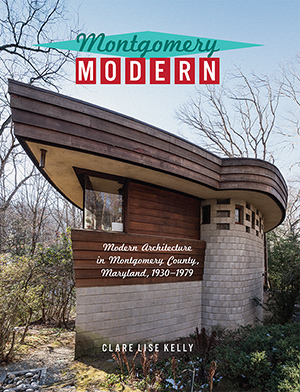Awards

Modern Montgomery: Modern Architecture in Montgomery County, Maryland, 1930-1979 by Clare Lise Kelly
- First Place award for Illustrated Text, Washington Publishers, 2016
- Heritage Education Publication Award, Montgomery Preservation, Inc, 2015
Book Reviews
Lying to the northwest of Washington, D.C., Montgomery County, Maryland, is one of many jurisdictions nationwide that were transformed during the second half of the twentieth century from a low-density scattering of villages and small suburban enclaves, all surrounded by rural land, to an integral part of a major metropolitan area. The intense development that occurred there during the post-World War II era should be seen as central to the county’s heritage. Clare Lise Kelly and the county planning agency of which she is a part deserve recognition for providing a detailed, insightful guide to this rich legacy. Montgomery Modern is a pioneering book of its kind, one that should greatly increase awareness of and appreciation for the array of buildings that have defined the county landscape. This volume should also serve as a model for similar undertaking nationwide.
—Richard Longstreth, George Washington University
Clare Lise Kelly’s new book Montgomery Modern provides a seminal historical accounting and perspective on how the international Modern Movement influenced architecture in Montgomery County in the middle of the 20th century. It exhibits a wonderful collection of buildings over a 49 year time span that responded to the Modern Movement nationwide as well as provided local examples of award-winning architecture that helped lead that movement. The book also serves to put in perspective how we view historic preservation. Whatever hesitancy we may feel towards placing significance on mid-century modern architecture can be balanced against similar hesitancies found in the early days of the Preservation Movement. At that time buildings of the early part of the 20th century were being assessed for their value historically during the Modern Movement and faced similar hesitancy and opposition. A conclusion can be drawn from this excellently researched and written book that preservation must be seen in the larger context of the long history of the built environment and not as a reflection of current trends and aesthetic preferences.
—William Kirwan, AIA, Principal of Muse Architects in Bethesda, MD and Chair of the Montgomery County Historic Preservation Commission.
